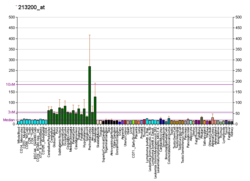突觸素
外觀
突觸素(Synaptophysin),又稱主要突觸小泡蛋白p38(major synaptic vesicle protein p38),是一種人體中由「SYP」基因轉譯而成的蛋白質[6][7]。
遺傳學
[編輯]該基因位於X染色體的短臂上(Xp11.23-p11.22),約由12,406個鹼基對所構成,位於反義股上。該蛋白由313個胺基所構成,分子量約為33.845kDa。
分子生物學
[編輯]該蛋白質為突觸小泡上的醣蛋白,擁有四個穿膜區。該蛋白主要表現於神經內分泌細胞,基本上只要擁有突觸傳輸功能的神經元皆會表達。在免疫染色組織學上,該蛋白常被作為神經內分泌腫瘤的標誌蛋白,或是用於突觸豐度的定量[8]。
目前該蛋白的確切功能尚未闡明,僅知他會與重要的突觸蛋白synaptobrevin產生交互作用。但在動物實驗中,即使將突觸素的基因剔除,似乎並沒有對動物的發育或功能上產生任何影響[9]。近期研究顯示,突觸素的缺失可能導致小鼠出現行為異常,例如探索行為增加、新奇物辨識(object novelty recognition),以及空間感上產生影響[10]。
交互作用
[編輯]突觸素可與AP1G1[11]和SIAH2[12]產生交互作用。
參見
[編輯]參考文獻
[編輯]- ^ 與突觸素相關的疾病;在維基數據上查看/編輯參考.
- ^ 2.0 2.1 2.2 GRCh38: Ensembl release 89: ENSG00000102003 - Ensembl, May 2017
- ^ 3.0 3.1 3.2 GRCm38: Ensembl release 89: ENSMUSG00000031144 - Ensembl, May 2017
- ^ Human PubMed Reference:. National Center for Biotechnology Information, U.S. National Library of Medicine.
- ^ Mouse PubMed Reference:. National Center for Biotechnology Information, U.S. National Library of Medicine.
- ^ Entrez Gene: SYP synaptophysin. [2021-01-14]. (原始內容存檔於2010-12-05).
- ^ Südhof TC, Lottspeich F, Greengard P, Mehl E, Jahn R. The cDNA and derived amino acid sequences for rat and human synaptophysin. Nucleic Acids Res. November 1987, 15 (22): 9607. PMC 306499
 . PMID 3120152. doi:10.1093/nar/15.22.9607.
. PMID 3120152. doi:10.1093/nar/15.22.9607.
- ^ Calhoun ME, Jucker M, Martin LJ, Thinakaran G, Price DL, Mouton PR. Comparative evaluation of synaptophysin-based methods for quantification of synapses. J. Neurocytol. December 1996, 25 (12): 821–8. PMID 9023727. doi:10.1007/BF02284844. 溫哥華格式錯誤 (幫助)
- ^ McMahon HT, Bolshakov VY, Janz R, Hammer RE, Siegelbaum SA, Südhof TC. Synaptophysin, a major synaptic vesicle protein, is not essential for neurotransmitter release. Proc. Natl. Acad. Sci. U.S.A. May 1996, 93 (10): 4760–4. Bibcode:1996PNAS...93.4760M. PMC 39352
 . PMID 8643476. doi:10.1073/pnas.93.10.4760.
. PMID 8643476. doi:10.1073/pnas.93.10.4760.
- ^ Schmitt U, Tanimoto N, Seeliger M, Schaeffel F, Leube RE. Detection of behavioral alterations and learning deficits in mice lacking synaptophysin. Neuroscience. August 2009, 162 (2): 234–43. CiteSeerX 10.1.1.320.5309
 . PMID 19393300. doi:10.1016/j.neuroscience.2009.04.046.
. PMID 19393300. doi:10.1016/j.neuroscience.2009.04.046.
- ^ Horikawa HP, Kneussel M, El Far O, Betz H. Interaction of synaptophysin with the AP-1 adaptor protein gamma-adaptin. Mol. Cell. Neurosci. November 2002, 21 (3): 454–62. PMID 12498786. doi:10.1006/mcne.2002.1191.
- ^ Wheeler TC, Chin LS, Li Y, Roudabush FL, Li L. Regulation of synaptophysin degradation by mammalian homologues of seven in absentia. J. Biol. Chem. March 2002, 277 (12): 10273–82. PMID 11786535. doi:10.1074/jbc.M107857200
 .
.
延伸閱讀
[編輯]- Kalina M, Lukinius A, Grimelius L, Höög A, Falkmer S. Ultrastructural localization of synaptophysin to the secretory granules of normal glucagon and insulin cells in human islets of Langerhans. Ultrastructural Pathology. 1991, 15 (3): 215–9. PMID 1908157. doi:10.3109/01913129109021883.
- Ozçelik T, Lafreniere RG, Archer BT, Johnston PA, Willard HF, Francke U, Südhof TC. Synaptophysin: structure of the human gene and assignment to the X chromosome in man and mouse. Am. J. Hum. Genet. 1990, 47 (3): 551–61. PMC 1683862
 . PMID 1975480.
. PMID 1975480. - Goto S, Hirano A, Pearson J. Calcineurin and synaptophysin in the human spinal cord of normal individuals and patients with familial dysautonomia. Acta Neuropathol. 1990, 79 (6): 647–52. PMID 2163183. doi:10.1007/BF00294243.
- de Koning JP, Schelen AM, Dong F, van Buitenen C, Burgering BM, Bos JL, Löwenberg B, Touw IP. Specific involvement of tyrosine 764 of human granulocyte colony-stimulating factor receptor in signal transduction mediated by p145/Shc/GRB2 or p90/GRB2 complexes. Blood. 1996, 87 (1): 132–40. PMID 8547634. doi:10.1182/blood.V87.1.132.132
 .
. - Zhang PJ, Rosenblum MK. Synaptophysin expression in the human spinal cord. Diagnostic implications of an immunohistochemical study. Am. J. Surg. Pathol. 1997, 20 (3): 273–6. PMID 8772779. doi:10.1097/00000478-199603000-00002.
- Bouwens L, Lu WG, De Krijger R. Proliferation and differentiation in the human fetal endocrine pancreas. Diabetologia. 1997, 40 (4): 398–404. PMID 9112016. doi:10.1007/s001250050693
 .
. - Fisher SE, Ciccodicola A, Tanaka K, Curci A, Desicato S, D'urso M, Craig IW. Sequence-based exon prediction around the synaptophysin locus reveals a gene-rich area containing novel genes in human proximal Xp. Genomics. 1998, 45 (2): 340–7. PMID 9344658. doi:10.1006/geno.1997.4941. hdl:11858/00-001M-0000-0012-CBE6-7
 .
. - Maggiano N, Lauriola L, Serra FG, Ricci R, Capelli A, Ranelletti FO. Detection of synaptophysin-producing cells in human thymus by immunohistochemistry and nonradioactive in situ hybridization. J. Histochem. Cytochem. 1999, 47 (2): 237–43. PMID 9889259. doi:10.1177/002215549904700212
 .
. - Portela-Gomes GM, Stridsberg M, Johansson H, Grimelius L. Co-localization of synaptophysin with different neuroendocrine hormones in the human gastrointestinal tract. Histochem. Cell Biol. 1999, 111 (1): 49–54. PMID 9930883. doi:10.1007/s004180050332.
- Davidsson P, Gottfries J, Bogdanovic N, Ekman R, Karlsson I, Gottfries CG, Blennow K. The synaptic-vesicle-specific proteins rab3a and synaptophysin are reduced in thalamus and related cortical brain regions in schizophrenic brains. Schizophrenia Research. 1999, 40 (1): 23–9. PMID 10541003. doi:10.1016/S0920-9964(99)00037-7.
- Cassiman D, van Pelt J, De Vos R, Van Lommel F, Desmet V, Yap SH, Roskams T. Synaptophysin: A Novel Marker for Human and Rat Hepatic Stellate Cells. Am. J. Pathol. 1999, 155 (6): 1831–9. PMC 1866940
 . PMID 10595912. doi:10.1016/S0002-9440(10)65501-0.
. PMID 10595912. doi:10.1016/S0002-9440(10)65501-0. - Thiele C, Hannah MJ, Fahrenholz F, Huttner WB. Cholesterol binds to synaptophysin and is required for biogenesis of synaptic vesicles. Nat. Cell Biol. 2000, 2 (1): 42–9. PMID 10620806. doi:10.1038/71366.
- Nag TC, Wadhwa S. Differential expression of syntaxin-1 and synaptophysin in the developing and adult human retina. J. Biosci. 2001, 26 (2): 179–91. PMID 11426054. doi:10.1007/BF02703642.
- Bhangu PS, Genever PG, Spencer GJ, Grewal TS, Skerry TM. Evidence for targeted vesicular glutamate exocytosis in osteoblasts. Bone. 2001, 29 (1): 16–23. PMID 11472886. doi:10.1016/S8756-3282(01)00482-3.
- Roudenok V, Kühnel W. The development of synaptophysin immunoreactivity in the human sympathetic ganglia. Ann. Anat. 2001, 183 (4): 345–51. PMID 11508360. doi:10.1016/S0940-9602(01)80177-1.
- Wheeler TC, Chin LS, Li Y, Roudabush FL, Li L. Regulation of synaptophysin degradation by mammalian homologues of seven in absentia. J. Biol. Chem. 2002, 277 (12): 10273–82. PMID 11786535. doi:10.1074/jbc.M107857200
 .
. - Ulfig N, Chan WY. Expression of a kinase anchoring protein 79 and synaptophysin in the developing human red nucleus. Neurosignals. 2003, 11 (2): 95–102. PMID 12077483. doi:10.1159/000058546.
- Yao I, Iida J, Nishimura W, Hata Y. Synaptic and nuclear localization of brain-enriched guanylate kinase-associated protein. J. Neurosci. 2002, 22 (13): 5354–64. PMC 6758191
 . PMID 12097487. doi:10.1523/JNEUROSCI.22-13-05354.2002.
. PMID 12097487. doi:10.1523/JNEUROSCI.22-13-05354.2002. - Wistow G, Bernstein SL, Wyatt MK, Ray S, Behal A, Touchman JW, Bouffard G, Smith D, Peterson K. Expressed sequence tag analysis of human retina for the NEIBank Project: retbindin, an abundant, novel retinal cDNA and alternative splicing of other retina-preferred gene transcripts. Mol. Vis. 2002, 8: 196–204. PMID 12107411.





